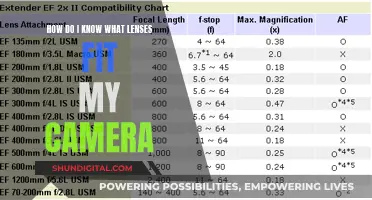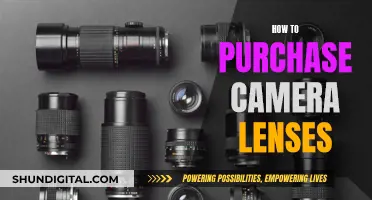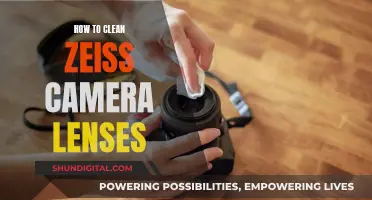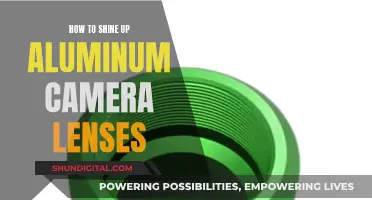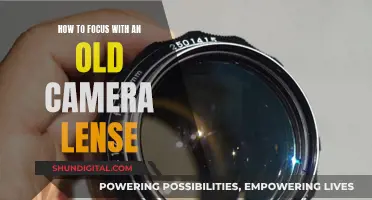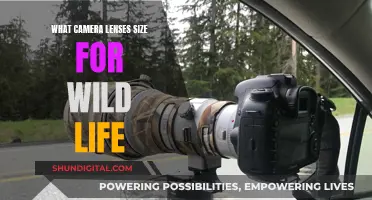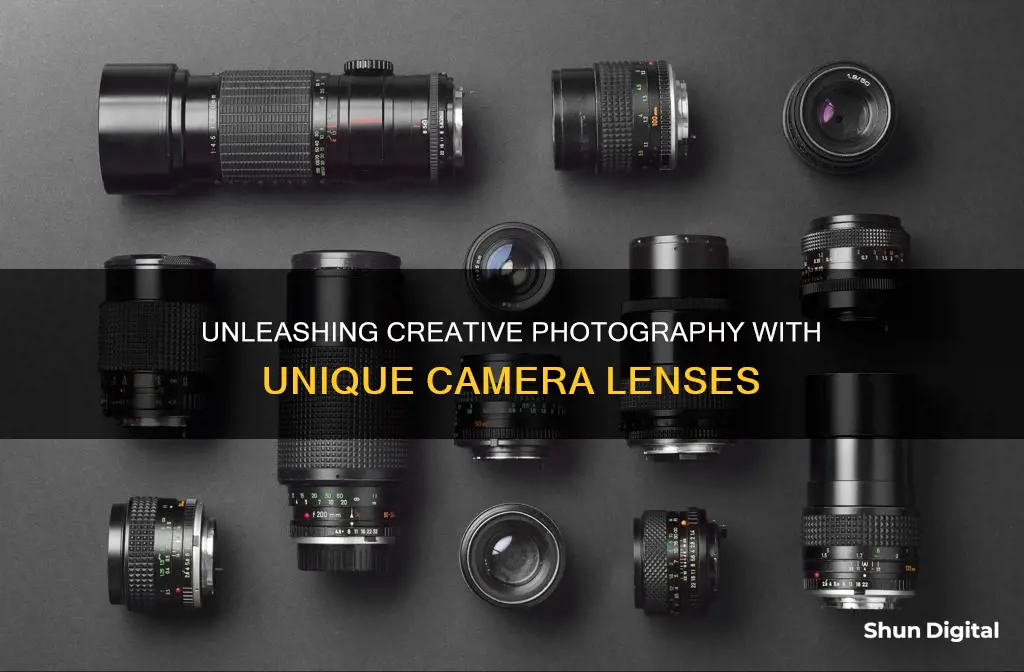
Camera lenses have come a long way since the dawn of photography, with modern lenses offering a wide range of features and capabilities that allow photographers to capture stunning images. From fast lenses with wide apertures to unique lenses that create dreamy, swirly bokeh effects, there are many options available to suit different needs and preferences. Some lenses are designed for specific purposes, such as macro photography, sports, or wildlife, while others offer more versatile features. In addition, some lenses stand out for their extreme specifications, such as the Canon 5200mm f/14 lens, which weighs over 200 pounds and is designed to focus on objects more than 30 miles away. Others, like the Lensbaby Burnside 35mm f/2.8, offer unique features like a dual-aperture design that allows for vignette control. So, whether you're looking for a lens that will help you capture artistic photos, unique portraits, or stunning wide-angle landscapes, there's sure to be a cool camera lens that fits the bill.
| Characteristics | Values |
|---|---|
| Lens Type | Fisheye, Macro, Ultra-fast, Lensbaby, Tilt-shift, Ultra macro, Perspective control, Creative |
| Aperture | f/0.95, f/1.2, f/1.4, f/1.8, f/2.8, f/3.5, f/4.5, f/11 |
| Focal Length | 50mm, 56mm, 85mm, 100mm, 150mm, 200mm, 200-500mm, 24-70mm, 24mm, 25mm, 29mm, 500mm |
| Brands | Canon, Fujifilm, Sony, Nikon, Rokinon, Olympus, Voigtländer, Venus Optics, Sigma, Panasonic Leica, Samyang, Lensbaby, Lomography, Meyer Optik Görlitz |
| Use Cases | Portrait, Landscape, Action, Close-up, Extreme Sports, Architecture, Wildlife |
| Other Features | Lightweight, Weather Sealing, Image Stabilization, Manual Focus, Bokeh, Autofocus, Wide Angle, Telephoto, Zoom, Perspective Control, Shift, Tilt |

Fisheye lenses
The history of fisheye lenses dates back to 1906, when physicist Robert W. Wood invented the lens, inspired by how a fish would view the world from beneath the water. However, it wasn't until the 1960s that fisheye lenses gained prominence through mass production and their use in films like "Seconds" by John Frankenheimer. Over time, they have become a popular choice for photographers and filmmakers alike, offering unique opportunities to capture more of the surrounding area and create a distinct mood.
When using a fisheye lens, it's important to consider the settings and technical aspects. Fisheye lenses typically have shorter focal lengths, with circular lenses ranging from 8mm to 10mm, and full-frame lenses having slightly longer focal lengths of around 15mm to 16mm. Additionally, the extreme depth of field in fisheye lenses can make it challenging to isolate your subject, so choosing an uncluttered background is crucial.
Understanding Your Camera Lens' Field of View
You may want to see also

Ultra-fast lenses
Handevision / Kipon Ibelux 40mm f/0.85 Mark II
This lens offers an incredibly fast maximum aperture of f/0.85 and is compatible with multiple camera systems, including Canon EF-M, Fujifilm X, Micro Four Thirds, Sony E, and Leica L mounts. While the original version received some criticism for its performance and price, the Mark II iteration provides improved optics and a more reasonable cost of $1,480.
Zhongyi Mitakon Speedmaster 50mm f/0.95
The Zhongyi Mitakon Speedmaster 50mm f/0.95 is a popular ultra-fast lens, offering a maximum aperture of f/0.95. It is available in three versions: one for full-frame DSLRs, one for full-frame mirrorless cameras, and a scaled-down version for Micro Four Thirds systems. The full-frame versions are priced at $799, while the Micro Four Thirds option is more affordable at $379.
Voigtländer Nokton 10.5mm, 17.5mm, 25mm, 42.5mm f/0.95
Voigtländer's Nokton series offers an impressive range of ultra-fast lenses for Micro Four Thirds cameras. With focal lengths ranging from 10.5mm to 42.5mm, these lenses provide a 2x crop factor, effectively performing like f/1.9 optics in terms of background blur. The longer focal lengths start at $799, while the wider options can go up to $1,099.
Leica Noctilux-M 50mm f/0.95 ASPH
The Leica Noctilux-M 50mm f/0.95 ASPH is a renowned ultra-fast lens, touted by Leica as "the world's highest-speed aspherical lens." With a maximum aperture of f/0.95, it excels in low-light photography, allowing handheld images to be captured using nothing more than candlelight. However, it comes with a hefty price tag of over $12,000.
Nikkor Z 58mm f/0.95 S Noct
Nikon's showcase lens for its Z-mount mirrorless system, the Nikkor Z 58mm f/0.95 S Noct, boasts an impressive maximum aperture of f/0.95. While it offers exceptional optical performance, its reported price of $8,000 may give potential buyers pause, especially when compared to other options on the market.
TTArtisan Noctilux 50mm f/0.95
For Leica M-mount users on a budget, the TTArtisan 50mm f/0.95 provides an affordable option for an ultra-fast lens. Priced at around $750, it offers a maximum aperture of f/0.95, making it a great choice for low-light photography and creating beautiful bokeh.
Fujifilm XF 50mm f/1.0 R WR
While being the "slowest" on this list with a maximum aperture of f/1.0, the Fujifilm XF 50mm f/1.0 R WR stands out as the only lens on the list with autofocus capability. This makes it the fastest autofocus lens currently available on the market. It is designed for Fujifilm's X-mount camera system and offers excellent performance for both stills and video.
Experimental Optics 42mm/50mm f/0.75
The fastest lens currently available, the Experimental Optics 42mm/50mm f/0.75, offers an astonishing maximum aperture of f/0.75. However, it is a fixed-focus lens designed for x-ray imaging and requires the use of a helicoid focusing mount adapter and an additional aperture blade kit for full functionality. This lens was funded through Kickstarter and is available for Leica M and Micro Four Thirds mounts.
Action Cameras: Fisheye Lenses and Their Uses
You may want to see also

Spy lenses
Hidden Camera Lenses:
- Desk Clock with a Hidden Camera and Wi-Fi: This portable hidden camera lens is a great choice for covert operations. It can be battery-powered or plugged in for continuous use. It features a built-in video recorder and a 120-degree field of view, making it perfect for discreet surveillance.
- Mini IP Camera with a Wide-Angle 2.8mm Lens: This tiny IP camera is perfect for full-room surveillance. It uses a Sony Starvis 1080P CMOS sensor to capture clear, full-colour images even in low-light conditions.
- Smart Cube Clock with WiFi DVR: This device offers discreet HD video surveillance with infrared night vision, remote viewing, and playback. It's a great option for those seeking a covert way to monitor their home or office.
- Android Charging Dock with Wi-Fi Hidden Camera: This hidden camera lens allows you to view and record video from your Android smartphone using a free app. It records to a micro SD card of up to 64GB, ensuring you capture all the important details.
- HD Pen Camera DVR: Disguised as an ordinary pen, this device contains a 1080p camera and video recorder. With the push of a button, you can record high-definition videos and store them on the built-in 32GB card.
Spy Camera Glasses:
Spy camera glasses are another innovative tool for discreet surveillance. These glasses typically feature built-in cameras that can capture photos or videos, and some even have built-in memory cards for storing your recordings. They are designed to look like regular eyeglasses, making them perfect for covert operations or hands-free recording while on the move.
The Myth of Circular Camera Lenses: Fact or Fiction?
You may want to see also

Macro lenses
The macro lens is a great way to capture the tiny details of a larger subject to create intriguing macro imagery. They are capable of achieving tack-sharp focus on the most minuscule of details, from the tiny hairs on the legs of an insect to the contents of a water droplet on a spring leaf.
There are a variety of macro lenses available, from wide-angle to telephoto, and they come in different focal lengths. The important thing to keep in mind is that the lens' focal length will determine your field of view, working distance available, and background blur capabilities when photographing your subject.
For example, the Canon EF-S 35mm f/2.8 Macro IS STM lens has a 35mm focal length and produces 1.0x magnification at its minimum focus distance of 5.1" (130mm). On the other hand, the Canon EF 180mm f/3.5L Macro USM lens produces the same magnification, but with a subject placed 18.9" (480mm) from the sensor.
The extra working distance provided by longer focal length macro lenses can be beneficial when photographing skittish subjects such as insects. Longer focal lengths also produce a more pronounced background blur, which can be great for showcasing your subject through isolation.
Some popular macro lenses include the Canon MP-E 65mm f/2.8 1-5x Macro, the Sony FE 50mm f/2.8 Macro, and the Nikon AF-S VR Micro-Nikkor 105mm f/2.8G IF-ED.
The Ultimate Camera Lenses for Professional Photography
You may want to see also

Tilt-shift lenses
A tilt-shift lens is a creative lens that allows photographers to adjust the perspective of the lens without moving the camera. It does this by allowing the photographer to change the position of the imaging circle, which is normally fixed in relation to the camera sensor. By tilting the lens, the photographer can change the centre of the imaging circle, which can straighten lines that appear to converge in the distance.
The tilt feature of a tilt-shift lens can dramatically change the plane of sharp focus. By tilting a lens left or right, you can change the focal plane from parallel to approaching-perpendicular to the imaging sensor, resulting in a plane of focus that runs vertically through the frame. This means that everything from the front to the back of the image can be in focus, even when using a moderately wide aperture.
The shift feature of a tilt-shift lens allows the lens' optics to shift in relation to the image sensor. Tilt-shift lenses are designed to project an image circle that is much larger than traditional lenses. By shifting a lens, you can simulate photographing your subject from a different camera position. This is particularly useful for creating architecture photos without converging vertical lines.
Megapixels: Camera Lens Quality or Marketing Ploy?
You may want to see also
Frequently asked questions
There are many unique lenses available on the market that can help you capture artistic photos and take your images to the next level. Here are some examples:
- Fisheye lenses — These lenses produce an ultra-wide-rounded effect, allowing you to distort corridors, warp skylines, and bend faces. They are versatile, fun to work with, and relatively inexpensive.
- Tilt-shift lenses — These lenses can tilt to adjust the plane of focus and shift to correct perspective distortion. They are often used to create a "tiny worlds" effect in photos, making scenes look like miniature models.
- Ultra-fast lenses — These lenses have a wide maximum aperture, such as f/1.8, f/1.4, or f/1.2, allowing for a strong background bokeh effect. They are great for creative photography, as well as low-light shooting.
- Macro lenses — Macro lenses offer high magnification, allowing you to capture unique images of small subjects, such as flowers, water droplets, or household items. They can be expensive, but there are alternative options like close-up filters, extension tubes, or the reverse-lens technique.
- Lensbaby lenses — These lenses allow you to adjust the focus and create a sharp subject surrounded by background bokeh. They are great for drawing attention to your model's face and can be used for creative abstracts and landscape shots.
Other unique lenses include the Lomography Petzval 85mm f/2.2, which is a contemporary version of the original Petzval lens from 1840, the Leica Noctilux-M 50mm f/0.95, known for its cult status and bright maximum aperture, and the Sigma 200-500mm f/2.8, a massive lens with a built-in battery to power its zoom and focusing capabilities.


